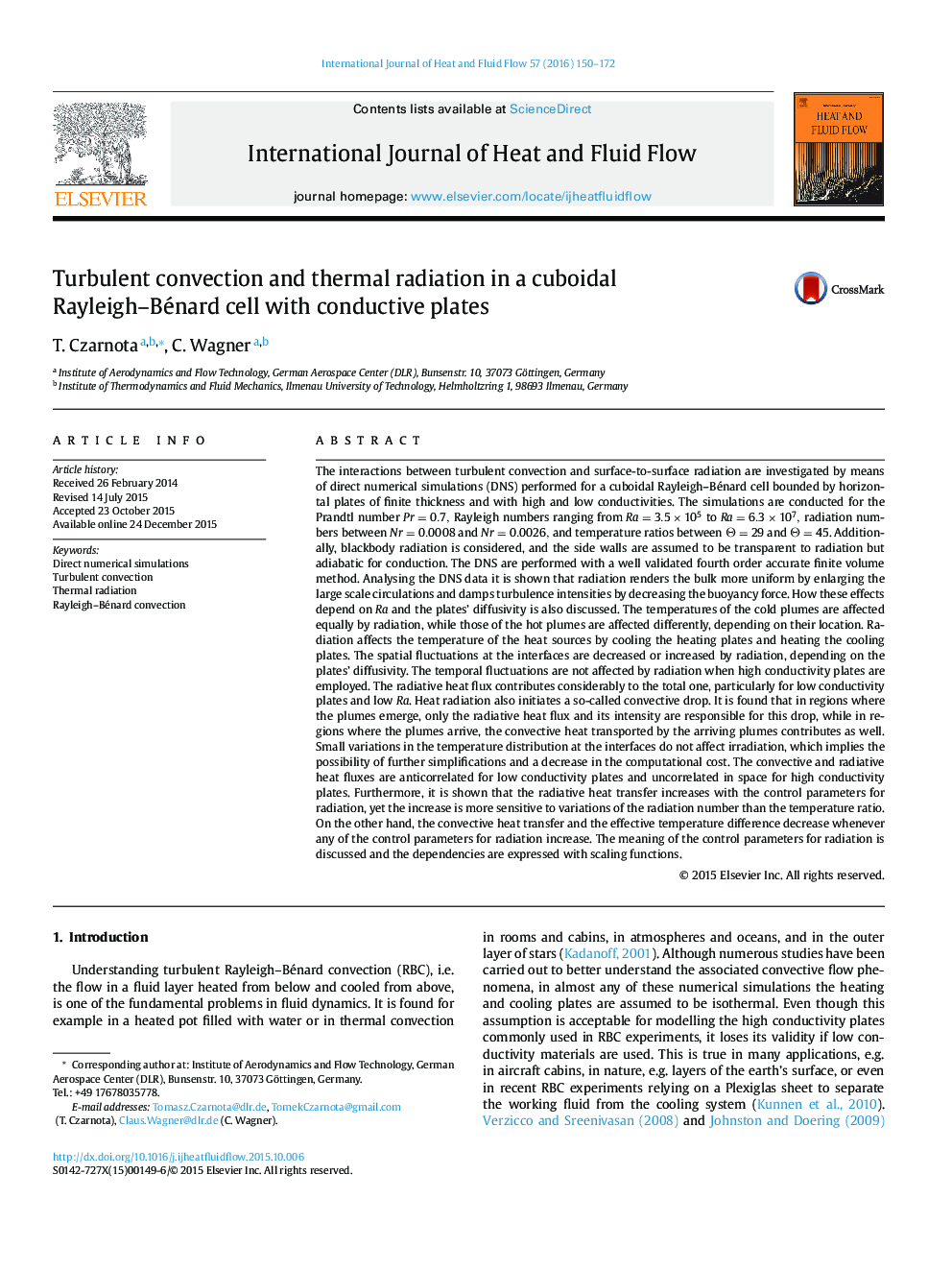| کد مقاله | کد نشریه | سال انتشار | مقاله انگلیسی | نسخه تمام متن |
|---|---|---|---|---|
| 7053598 | 1457624 | 2016 | 23 صفحه PDF | دانلود رایگان |
عنوان انگلیسی مقاله ISI
Turbulent convection and thermal radiation in a cuboidal Rayleigh-Bénard cell with conductive plates
دانلود مقاله + سفارش ترجمه
دانلود مقاله ISI انگلیسی
رایگان برای ایرانیان
کلمات کلیدی
موضوعات مرتبط
مهندسی و علوم پایه
مهندسی شیمی
جریان سیال و فرایندهای انتقال
پیش نمایش صفحه اول مقاله

چکیده انگلیسی
The interactions between turbulent convection and surface-to-surface radiation are investigated by means of direct numerical simulations (DNS) performed for a cuboidal Rayleigh-Bénard cell bounded by horizontal plates of finite thickness and with high and low conductivities. The simulations are conducted for the Prandtl number Pr=0.7, Rayleigh numbers ranging from Ra=3.5Ã105 to Ra=6.3Ã107, radiation numbers between Nr=0.0008 and Nr=0.0026, and temperature ratios between Î=29 and Î=45. Additionally, blackbody radiation is considered, and the side walls are assumed to be transparent to radiation but adiabatic for conduction. The DNS are performed with a well validated fourth order accurate finite volume method. Analysing the DNS data it is shown that radiation renders the bulk more uniform by enlarging the large scale circulations and damps turbulence intensities by decreasing the buoyancy force. How these effects depend on Ra and the plates' diffusivity is also discussed. The temperatures of the cold plumes are affected equally by radiation, while those of the hot plumes are affected differently, depending on their location. Radiation affects the temperature of the heat sources by cooling the heating plates and heating the cooling plates. The spatial fluctuations at the interfaces are decreased or increased by radiation, depending on the plates' diffusivity. The temporal fluctuations are not affected by radiation when high conductivity plates are employed. The radiative heat flux contributes considerably to the total one, particularly for low conductivity plates and low Ra. Heat radiation also initiates a so-called convective drop. It is found that in regions where the plumes emerge, only the radiative heat flux and its intensity are responsible for this drop, while in regions where the plumes arrive, the convective heat transported by the arriving plumes contributes as well. Small variations in the temperature distribution at the interfaces do not affect irradiation, which implies the possibility of further simplifications and a decrease in the computational cost. The convective and radiative heat fluxes are anticorrelated for low conductivity plates and uncorrelated in space for high conductivity plates. Furthermore, it is shown that the radiative heat transfer increases with the control parameters for radiation, yet the increase is more sensitive to variations of the radiation number than the temperature ratio. On the other hand, the convective heat transfer and the effective temperature difference decrease whenever any of the control parameters for radiation increase. The meaning of the control parameters for radiation is discussed and the dependencies are expressed with scaling functions.
ناشر
Database: Elsevier - ScienceDirect (ساینس دایرکت)
Journal: International Journal of Heat and Fluid Flow - Volume 57, February 2016, Pages 150-172
Journal: International Journal of Heat and Fluid Flow - Volume 57, February 2016, Pages 150-172
نویسندگان
T. Czarnota, C. Wagner,